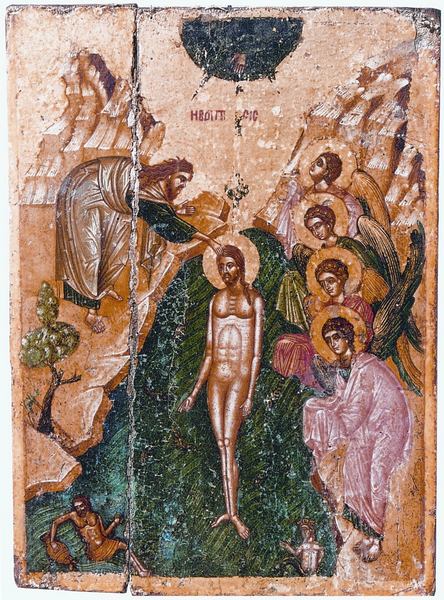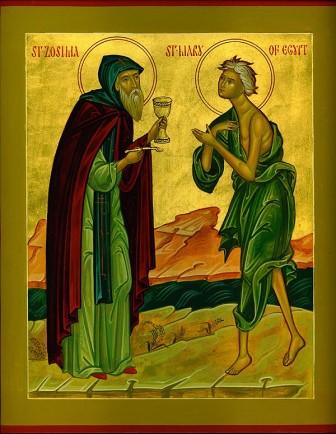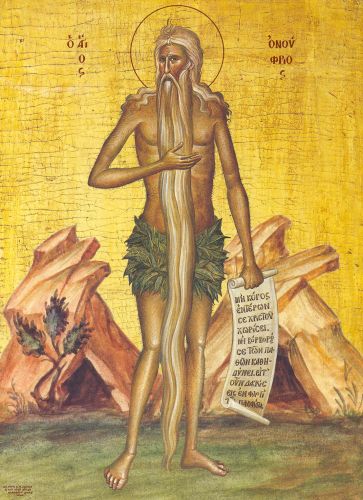
Today we shall analyze the icon of the Lord's Baptism. The events
that took place are depicted according to the description in the
Gospel. The Baptism of Christ was an introductory act - by
Christ - prior to His public opus. Christ was baptized in
public. Christ did not need to be baptized.
Theologically speaking, there are two reasons for Baptism. Firstly,
it is for the elimination of sins committed up until the day of
Baptism. And secondly, to be released of the consequences of
the original sin. Baptism does two things: it rids you of sins
you have committed and it releases you from the original sin.
On sins, you might say that an infant hasn't committed any; well, I can't say if it did or didn't; even an eruption of tears by a child
could be for an egotistic reason. However, there certainly is the release from the
consequences of the original sin. Notice here, that it depends
on how you view this matter. No-one is responsible for the sins of
Adam and Eve. We are not to blame. Then you may ask why should we be
released from something that we didn't do. Pay attention here:
If I, as an irresponsible being, were to toss poisonous gas into
this room and you all became sick in your lungs, it would not be
your fault - it would be my madness that did it. Therefore,
someone has to protect you from the consequences of that "original"
mistake that I made (by spraying toxic gas into this room), before
you'd need to think about it.
Original sin was NOT JUST a personal thing that Adam and Eve committed.
That sin upset everything; all of Creation - even man's relationship
with nature, with animals... with everything. Everything was
upset. And even though whoever is born, is born as not responsible
(for that original sin), we are nevertheless born in a turbulent and
sinful atmosphere.
And the Church - precisely - strives, just as you strive to save a
child that has blamelessly found itself in a polluted environment
and protect it, so the Church wants to rid and protect mankind of
the consequences of that existing original sin. In other
words, it is not about the logic of what I did or didn't do.
That is the reason you see us baptizing our children at a young age
- it is precisely to protect them from those consequences.
Because, as unbaptized beings, they will be participating in a
disturbed world; and that would be like living in a place where your
child becomes sick and telling it that it has to wait until it is
fifteen so it can decide if it wants to be cured or not. But
then it will be too late. What about the many other things we
do in our lives? For example, we give our child milk and we
clothe it so it can go to school. Do we ask it? No, we don't.
It can decide later, when it has acquired a rationalizing mind, to
say it doesn't want that. Likewise with the child's freedom - if
it has been baptized - entails the ability to state that "I don't wish to be a
Christian". That is its personal, free choice. Baptism doesn't
hinder the child in any way, with regard to its personal freedom. Anyway, I am saying
all this in order for you to become familiar with the theology of
Baptism.
Now, Christ was baptized, but without either of the two
aforementioned manifestations. There was no case of needing to be
rid of original sin, nor was there the notion of Him having any sin.
He was sinless. Christ conceded to being baptized, in order to
condescend to all things human and to demonstrate what we should do.
Without needing to, He was baptized. That is why John the Baptist
wondered, and asked Him: "But, am I to baptize YOU?" And
Christ replied "Leave it, for the time being. Things have to be done
differently; we must fulfil every justice." (Matth.3:15) The words
"every justice" signifies "everything humble". To us,
"justice" does not mean to demand justice. We are the ones who
place justice in the world. Extreme justice is the extreme
humility that a man can reach. "Just" is the one who is humble -
not the one who seeks to be justified.
So, we have this Icon of the Baptism, where we observe the revealing
of the Holy Trinity. In the water is Christ of course. We have
the descent of the Holy Spirit, which comes in the form of a dove.
And above them can be heard the voice of the Father. We never
depict the Father. The voice of the Father is heard. We therefore
have here the revelation of the Holy Trinity.
I will stress something that I have said in the past. The Holy
Spirit is "like a dove". Be careful here. Christ is not "like a man"
- He is in fact a Man. The word "like" has a different meaning, and
the word "as" has another meaning. I function AS a doctor, if I am a
doctor. I function LIKE a doctor means I am emulating a doctor. The
Gospel says "like" a dove (Matth.3:16). This does not imply that the
Holy Spirit became incarnate, became "dove-like" inside the dove.
Christ however - the Divine Nature of Christ did in fact become
incarnate within a man. Pay attention to this fact. We have
one Person, in two natures (One Christ in two natures - 4th
Ecumenical Synod). Be careful here: NOT one person WITH two natures.
NOT WITH TWO NATURES. It is one Person, in which the two
natures participate. In a mystical way. Two natures
participate, but there is only one person, in which those two
natures participate.
Christ assumes something in His Person. What does He assume?
His Divine Nature assumes human nature in order to heal it. That is
the reason He assumes it. According to Gregory the Theologian,
whatever is not assumed cannot be healed. That is why the
Church's work is to always assume therapeutically. Whatever is
not assumed cannot be cured. Christ, therefore, is the incarnate Son
and Logos of God. He is the one Person in two natures.
We have the revealing of the Holy Spirit, which appears like a dove.
And there is a symbolism to this dove. Remember how a dove came to
Noah, bringing him the message that the waters had receded.
The symbolism goes back to the Old Testament.
Christ enters the water and sanctifies all of Creation. Christ here
can be portrayed naked - entirely naked. Elsewhere, they portray Him
with a cloth around His waist. In our iconography, we aren't afraid,
nor do we have any hesitation to portray nudity. We aren't moralists
in matters like these. What is important, is what kind of nude
you are portraying. Even in everyday life, how can you be naked in
front of everyone? One can of course say "I'm free. I have no
problem. I can be naked." But what is the position of our Church?
What kind of nakedness does our Church depict? It depicts
ascetic nakedness. Ascetic nudity. You see, that kind of nudity is
not provocative. All those furrows on Christ's body denote an
ascetic body. Our Church does not engrave any provocative
lines. They are solemn lines. Nudity, therefore, to us is not
shameful. Adam and Eve were naked and "were not ashamed". It
is not a problem for us. A clothed body can be surpassed by
nakedness, if ascesis is involved. In other words, if someone
were to say to me "I want to be a nudist" I will say to him "I have
no objection, as a spiritual father"; I won't say "oh, you're
a nudist therefore you're a sinner". Because then he will say
"Saint Mary of Egypt and Saint Onuphrios lived naked in the desert."
Certainly. Then you too should try forty-five years of repentance
and tears in the desert, and then go naked, become a nudist. I will
have no objection. But that is an entirely other approach.
Therefore, I won't scold and say "oooh, naked"...etc.. I will
suggest becoming ascetic like Saint Onuphrios and like Saint Mary of
Eygpt, shed tears etc., and if you become a nudist, I will have no
objection whatsoever. See? This is another approach...
Sometimes we scold in a moralistic manner, for things that we
ourselves project.

 Saint Mary of
Egypt
Saint Onuphrios
Saint Mary of
Egypt
Saint Onuphrios
In this icon, Christ is depicted as naked. Christ enters the water,
and, according to the standards of our baptism, the one being
baptized must immerse himself three times in the water - in the name
of the Father, of the Son and of the Holy Spirit. The triple
immersion denotes the assumption of overall creation. That is how
our children are baptized. Our tradition requires that our children
be baptized with three immersions. We must not place the child in
the font and merely wet its head a little. Roman Catholics do
not observe the triple immersion. Anyway, the Roman Catholic baptism
is not valid. That is why canonically, we must re-baptize Roman
Catholics. Because to say the least, their baptism is not the
canonical one. Their baptism involves sprinkling, whereas
Tradition tells us that Christ Himself entered the water three times
- a triple immersion. These are very specific things and
no-one should tamper with them.
Next to Christ is Saint John the Baptist, who is baptizing Him. He
has placed his right hand upon the Lord's head and the other hand is
outstretched - which signifies acceptance: that is, he has accepted
the event. An acceptance of the event and a gesture of prayer
at the same time. Also an act of motion, of touching Christ.
Every mystery is performed though material means, and through touch.
You know how a priest will read a blessing, put on his stole, and
place his hand over your head. Everything is done through
fleshly contact. Christ Himself had touched the sick man when
He healed him. When the hemorrhaging woman touched Him, He
said "Someone has touched me" (Luke 8:46) - Someone has touched
me... this is a fleshly assumption here... As you can also
see, the Baptist is depicted with his legs apart, in motion. This
denotes the fact that he was sent forth to do his work.
The angels however, in this ministry of theirs in the Baptism, are
liturgical spirits. They were not sent to simply serve; they have a
liturgical function: they minister to Christ. Their legs are
together, standing at attention. So, the Baptist is an envoy in the
icon as we can see... An envoy, which is why he is portrayed with
his legs apart - because he is moving towards Christ. He has a
service to render - a ministry. Now observe the angels. We need to
know certain basic points. We can see the bands on the angels - we
have learnt earlier what they signify - but notice also that their
feet are together; they are "closed" by way of ministering, of a
position of ministering or officiating. At the same time, their
hands are covered as you can see. If they did have any ministering
to attend to - a specific mission, like the Baptist had - their
hands would have been uncovered. But here they are covered.
And as we have said before, this is
reminiscent of the liturgical vestment called "phelonion". It is
worn by the priest during the Liturgy and it covers his arms,
because he is not doing an act of his own. He is doing the work of
Christ.
At the bottom of the icon there are two little people, which also
have a symbolic meaning. They symbolize the Jordan River and the Red
Sea. You see, in the Holy Bible even lifeless objects are
"impersonated". «The Jordan turned back». (Psalm 113). It turned
back. As though it moved of its own accord, if it had a will. That
is what the two figures symbolize. They take on a personality. That
is why we depict the two basic expressive media of water, which have
a place in the Holy Bible. We have the Red Sea and the Jordan - the
two waters. The Red Sea is a pre-symbolism of the Jordan. And even
though they are both lifeless subjects, their normal flow is
changed: The Red Sea waters parted, and Moses with the Hebrews
crossed over. In this case, the flow of the Jordan changed, when it
received Christ in its waters.
Then there are the rocks. We will quite often see rocks in our
hagiography. The expressive rocks. These rocks are strange; they are
never depicted as gentle, rolling hills etc... they are abnormal or
uneven in comparison to human normalcy. As you can see in the icon,
this here is a mountain. The Baptist's stature is very nearly the
same as the mountain's; you see, balances are changed. The
perspective in the icon is also changed. We are more concerned with
the persons. Creation bows before the Creator. (That mountain could
have been Mount Sinai, with Moses depicted atop the mountain
appearing taller than Mount Sinai, which is 2240 metres high!) But
the mountains are sloping downwards slightly, in other words they
have bent over, in a position of solemn prayer. All of nature has
subjected itself to this Event, and that is why you see this
slanting. It is as though they are bowing their heads - just like
the angels, whose heads are also in a reverent position.
There is a certain "oddity" here, which I have found in the
iconography of Theophanes the Cretan; he occasionally portrays in
profile. I could never interpret the reason he did this. We never
accept profiles in our icons. Theophanes however inserts a few
profiles here and there. But they continue to be a puzzle to me...
Such a great hagiographer, doing such a thing? I don't know why...
Anyway, the profile was never embodied in the space of our
hagiography.

In the icon one can also find little trees and a few other
symbolisms also. For example, an axe leaning against a tree, as
mentioned in the Holy Bible. It is waiting for the tree to grow.
Will it bear fruits? Or will it remain barren? If it doesn't bear
fruits, it will be chopped down. If it bears fruits, it will
be saved. So, along comes the Baptist with his "two-edged
sword" - that sharp, cutting instrument - in other words, his sermon
and his cutting words, against which we must weigh ourselves.
That was in brief the Icon of the Baptism.
If there is something you would like to ask, you may do so.
************
Question: The Holy Spirit appeared "like" a dove. Was it like
a real dove? Or was it something like a flash of light in the shape
of a dove?
Answer: No, it was like a real dove. Like a dove. But that
doesn't mean the Holy Spirit became incarnated in the dove. It
appeared at that moment, symbolically.
Question: Do angels always have the same kind of
garment, of that past era?
Answer: Yes, that is how they are portrayed; It is not a
material garment. Angels are enrobed with the Light... "Whosoever is
baptized in Christ, has donned Christ..." (Galat.3:27) It is a
garment of light. They are clothed with light. And it is
in this manner that we approach this detail.
Question: Does each era portray Angels with its own form of
attire? For example with Roman uniforms?
Answer: No. We always portray them with luminous robes. What
you mention is a much later trait, and it basically has to do with
local folklore which gradually permeated hagiography.
Especially during the Turkish occupation, many such human-centered
elements came into use. For example, military appearances
etc.. That is not proper. We do not portray our Saints (such as
Saint George and Demetrius) laden down with military attire. Nor do
we put them on a horse slaying a dragon. None of these. These are
saints that have put on the breastplate of faith, and the helmet of
trust in God. Paul the Apostle says so: «A breastplate of faith and
love and a helmet of hope for salvation» (1Thess.5:8). These are the
things we portray in iconography; not the soldier's weapons. The
Saint has transformed them and has thus acquired other "weapons" -
the weapons of faith - and that is what we depict. All the other
folklore details are inappropriate. And tens of such images also
passed into hagiography, through mimicking western icons, but also -
exceptionally - through perceptions during the time of the Turkish
occupation, when we had those expectations of prophecies (the "Red
Apple-tree") and other such things.
Question: Were there people present during the Baptism of
Christ? Because there aren't any people portrayed in the icon.
Answer: Yes, there were. People were always swarming around
the Baptist. Hundreds of people. And you should note here that
Christ's first disciples were John's disciples. So, we could say
that they "transferred" later on: Saint John the Baptist told them
that they must now follow Jesus. Therefore yes, there were
other people when Christ went to be baptized. And that is a
sure fact, it is not just a possibility. There most definitely were
prospective disciples of Christ among the crowd. Then the Baptist
also told them: «He must be magnified, and I must decrease» (John
3:30). Therefore there had been witnesses present - future disciples
- who recorded the Gospel. As simple as that. But, what we haven't
seen, we do not describe.